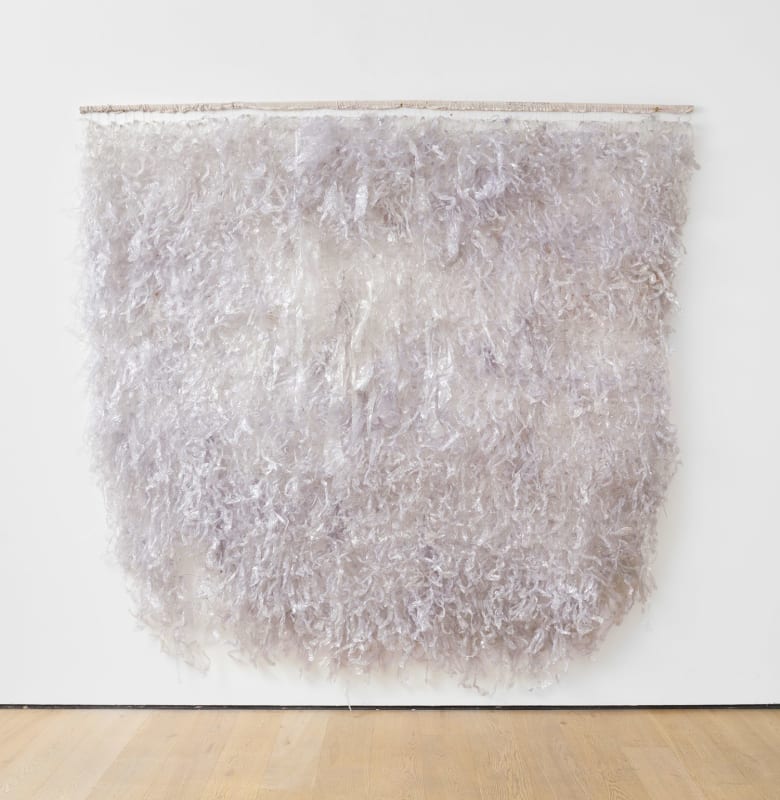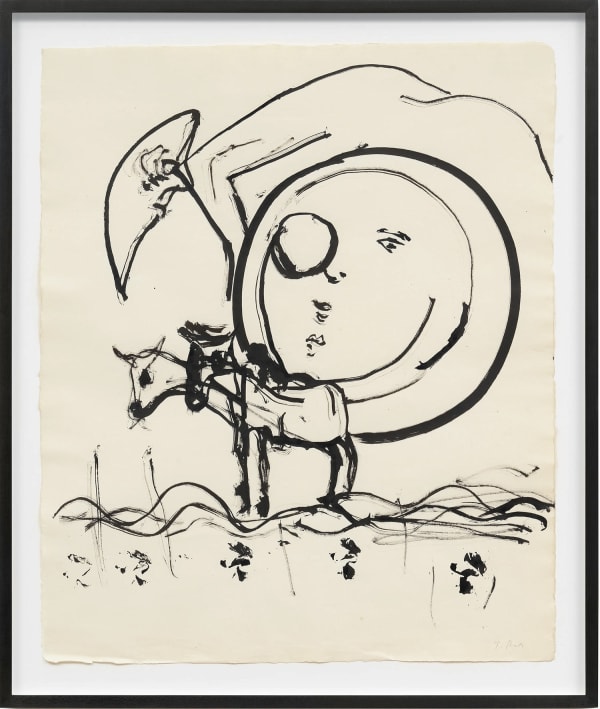White Drops: Tobias Pils, Barbara Levittoux-Świderska, Seth Price, curated by Regina Fiorito
WHITE DROPS
I once found myself lost in a city, its faces, sounds, scents, and crevices. Overrun by the incessant stream of fragmentary images that pass through the senses and seep into the mind. Faced with overwhelming stream of impressions, Rilke spoke in his letters of slowly learning to recognize “something solitary that one can gently take part in.”[1] In my mind that “something solitary” has always been akin to accessing a place of shadows; you go behind the thing attempting to, almost blindly, weave together strands of memory. And in a way these works could be seen as transforming the gallery space into such a place, a monochromatic landscape of shadows and fragments. Can the fragmentary ever be assembled to liken something complete?
At the core of Barbara Levittoux-Świderska’s imposing monochromatic textile works characterized by an organic fluidity is the artist’s craftsmanship. Levittoux-Świderska constructed her textile works from less conventional materials often combining artificial with natural materials such as plastic foil and sisal as in the present case. The weaving method of exposing the threads that would otherwise lay hidden behind the surface of the tapestry creates a sense of intimacy. At the same time there is a strong sense of defiance and a discarding of pretentions. The tapestry is not a tightly sewn together entity hanging flat on a wall. Shreds, or rather fragments, of material are instead seemingly loosely bound together to form an entity albeit a fragile one.
The works of Tobias Pils are reminiscent of a dream landscape populated by figurative and abstract elements in tones ranging primarily from white through grey to black. I attempt to dissect the fragments I encounter – a feather here, a square there and a human form somewhere else – at an attempt to assess the whole. Pils’ compositions masterfully draw the viewer in, transforming the eye into a camera lens zooming in and out of the works. The viewer is tempted to delve deeper; there are stories to be heard in these nocturnal landscapes that unfold. And the figures Pils puts forth are their echoes, the fragments of such tales.
Seth Price’s vacuum formed female breast protruding out of a white vacuum-formed high-impact polystyrene surface stamped with the year of “production” 2008 screams “plastic fantastic” and yet I am brought to consider the method employed. Molding the body is an attempt to reproduce it, and thus duplication implies a commercialization. However, what is reproduced is a shell and what remains behind the mold, the shiny plastic exterior in its shadow, is simply a vacant spot, a fantom.
The exhibition lends its title from one of the exhibited works by Levittoux-Świderska White Drops.In their interaction the exhibited artists’ works begin to resemble a dance of shadows swaying the way Levittoux-Świderska’s sculptural textile works adapt to the movements in the room. In essence what one could make out is the fragmentary nature permeating form and composition and thus our seeing and interpretation of them. I am led to consider whether the fragmentary is all there is. And it is fluid – white drops ever flowing. /Corina Wahlin
The evolution of textile art from flat wall decorations to three-dimensional sculptural works can to a large extent be attributed to Polish textile artist Barbara Levittoux-Świderska (1933–2019). Despite this, the immensely influential artist has been habitually overlooked during the decades. The Warsaw-native Levittoux-Świderska studied painting (1958) and tapestry (1959) at the Academy of Fine Arts and was part of the Polish Textile School, a generation of post-war artists who employed a politically charged practice, something which Levittoux-Swiderska’s art continued to embody throughout. Throughout the years her works have been exhibited in numerous group shows in Warsaw including the National Museum, Museum of History, Palace of Culture and 'Fibre Structures from Poland's New Wave of Textile Artists', which toured various venues across the United States including the Smithsonian Institute in Washington, D.C. During the years 1966 and 2013 solo exhibitions include she staged more than 40 solo exhibitions of her work. Biennales include the International Tapestry Biennales in Lausanne in 1975, 1985 and 2009. Her work can be found in several private and museum collections, amongst other the National Museum in Warsaw and Poznań, as well as the Textile Museum in Łódź. Awards include a life-time award for her achievements in textile (2010).
The Vienna-based Austrian artist Tobias Pils works primarily consist of mixed media paintings representing abstract and figurative elements. The palette he employs ranges from white to grey and black. Solo and two-person exhibitions include inter alia the Josef Albers Museum, Bottrop, Germany (2017); Le Consortium, Dijon, France (with Michael Williams, 2017); Chinati Foundation, Marfa, Texas (2016); and Secession, Vienna (2013). Group exhibitions include Picasso et la bande dessinée, Musée Picasso, Paris (2020), Jay DeFeo – The Ripple Effect, Aspen Art Museum, Colorado (2018); Le Consortium Collection, Le Consortium, Dijon, France (2018); and Spiegelnde Fenster, 21er Haus, Vienna (2017). Works by Pils are on permanent display at Kunstmuseum Bonn, Germany, and at the Renzo Piano-designed campus of École normale supérieure Paris-Saclay, Gif-sur-Yvette, France. Pils’ work is in the collections of Albertina, Vienna; Kunstmuseum Bonn, Germany; and Le Consortium, Dijon, France among others.
New York-based Seth Price, born in East Jerusalem and raised in Boston, is an acclaimed multi-disciplinary artist who with the employment of a wide-range of media explores themes such as the alienation of self and increasing abstraction and the tension between material life and dematerialized life.[2] Recent solo exhibitions include the Museum Brandhorst, Munich, The Wattis Institute in San Francisco, the Aspen Art Museum, MoMA/PS, the Institute of Contemporary Arts in London and the Stedelijk Museum Amsterdam. He has participated in Documenta 13 (2012) and the Venice Biennial (2011). Among the works exhibited in White Drops is Untitled, 2008 (vacuum-formed high-impact polystyrene) which is part of the artist’s renowned Vacuum Forms series of monochrome vacuum-formed canvases from 2008.
-
 Tobias Pils, Night (two moons), 2018
Tobias Pils, Night (two moons), 2018 -
 Tobias Pils, two moons, 2018
Tobias Pils, two moons, 2018 -
 Tobias Pils, Untitled, 2020
Tobias Pils, Untitled, 2020 -
 Tobias Pils, Untitled (candles b.f.), 2014/2015
Tobias Pils, Untitled (candles b.f.), 2014/2015










